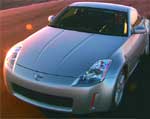
Nissan wanted a film look on a video budget. Varuna Films used a CineAlta camera to shoot the spot, out of TBWA/Chiat/Day.
|
For awhile, it seemed like high definition technology was too far ahead its time to have any near-term application for TV commercials. But what's happening now is something akin to the result of advice in "Hints From Heloise." She who prescribes use of hair shampoo for washing clothes or bringing along clothespins for completely closing hotel room drapes might also have come up with the current application for 24p cameras.
She might have said something like, "Substitute 24p for film acquisition and later downconvert to standard definition. You'll achieve a film-like look, save in costs and have more flexibility with effects."
Of course, the real credit in getting this message across more properly goes to Sony and Young & Rubicam, who initially collaborated in January 2002 on "The Dreams Project" to show the capabilities of HD. Eight top directors were set up with Sony CineAlta HD production equipment and post production facilities to shoot material on the subject of dreams. This was then shown to an audience of advertising and production people. A second installment with eight more directors, called "Dreams 03/Joy" was screened earlier this month at the Ziegfeld Theater in New York.

Young & Rubicam's campaign, featuring Carrot Top, for 1-800-CALLATT was shot in 24p and posted at 30fps.
|
THE AGENCIES
To Nancy Axthelm, executive VP, director of broadcast production at Grey Worldwide, New York (www.greyglobal.net), this project has helped stimulate a renewed interest in a format that is still a way off from accomodating TV commercials on-air.
"We were incredibly early adaptors of HD," she notes. Three or four years ago, we did stuff for Panasonic and Procter & Gamble for HD airing, when everyone thought it was going to happen, but the world is still slow to adapt to it. What's gained interest is what they've done with the Sony 24p CineAlta project. This has brought creative attention to digital shooting. There are limited places to run in HD but it can produce a beautiful image. It's a different medium that has to be embraced by itself."
She points out that, while the film community can be comfortable with remaining in 24fps, she has yet to see any Academy Awards for cinematography going to 24p product, despite the fact that "It's becoming a medium that looks beautiful." (Editor's Note: A recent American Cinematographers Award was given to DP Robert Primes for his work on the television show MDs, which was shot in 24p, beating out traditionally shot shows. So to quote Mr. Dylan: the times, they are a changin'.)
Axthelm sees Sony and Panasonic gradually improving the technology to deal with such limitations as the ability to shoot at high speed. "It will be a slow adaptation by directors," she comments, "as 24p becomes more user friendly and directors come to realize how friendly it already is. The post houses are already happy to work in any medium that you want."
At Young & Rubicam, New York (www. youngandrubicam.com), associate partner/ broadcast producer Paisley McCaffery says, "I look at HD as another tool if a specific creative piece lends itself to it - for example, if you're going to do a cinema release, you can shoot and finish in 24p."
She sees a range of advantages to working in 24p:
- Shooters can roll continually without reloading. For example, in a two-camera shoot, more scenes can be shot during a day, and there's a slight savings for using tape versus film.
- If a great deal of compositing is involved, it's easy to pull a matte from a digital source
- The look of the footage can be determined on set, for example, by looking at the monitor while setting up a blacked-out tent. "What you see is what you get."
- If working in an offline facility that doesn't have HD capabilities, the material can be downconverted to 30fps. Of course, this nearly cancels out the savings in the medium.
- If you stay at 30 frames in the finish, the quality differential is minimal, and it's a smart way to go if you're distributing to broadcast.
"What I've been doing," McCaffery reports, "is going to color correction at 30 frames. The quality differential is minimal and we maintain our budget. We spend less time in color correction because we've already established what we were going for during the shoot. Time spent is one-quarter to one-third less."
Y&R has done more than 14 commercials in the AT&T "1-800-CALLATT" campaign, which features comic Carrot Top, in HD, posting them at 30fps.

Shooters COO Ray Carballada: "When people see a standard definition commercial following an HD commercial, there's going to be a perceived difference in quality."
|
Another application for 24p is shooting for DVD production. This is what happened in a Nissan commercial overseen by TBWA/Chiat/Day, LA, working with Designory, a Long Beach, CA, agency specializing in multimedia. Jason Morgan, VP of development for LA production company Varuna Films (www.varunastudios.com), says the group of commercials for the Nissan 350Z sports car was shot in 24p because the budget did not allow 35mm, while the client wanted a 35mm look.
"Since this was going onto disc," Morgan states, "we wanted to keep it in the digital realm for economics and image quality. We prefer to shoot in HD because it provides flexibility and extreme savings over film stock. We're able to shoot three times as much because there's no reloading of film involved and we don't have to worry about stopping to cut takes. When it comes to editing, we have all kinds of different options."
Agencies eat up the available options during the shoot, he notes. "You can experiment with lenses, zooms, reverses and different kinds of shot angles. Agencies love to suggest new ideas during the shoot, and they can."
Because HD is new, he adds, there are still some issues. For example, it's a video format, so it still requires a DP who is used to shooting video and, for example, accounting for the fact that the whites can't be overexposed. He also points out that post facilities equipped for HD are still few and far between.

Grey's Nancy Axthelm: Sony's "Dreams" projects have brought attention to digital shooting within the agency world.
|
THE POST HOUSES
Those that are equipped, like Grace & Wild (www.gracewild.com) in Farmington Hills, MI, have seen more HD work come their way. President Steve Wild says his facility is transferring some projects in HD in order to create zoom-ins and provide a wider range of alterations in image size. Compared with posting in standard definition, he says, the cost is about 10 percent greater across the board - for telecine, editorial and tape purchase. Compared with film, though, there are savings in shooting stock and film-to-tape transfers.
Grace & Wild has two HD telecines, three HD editing systems and resolution-independent graphics, enough hardware to negate the prospect of scheduling problems.
Wild sees the added cost of shooting in HD and downconverting as good insurance that commercials can be used again when HD hits the airwaves. "If you don't want to re-create the editorial process," he says, "it's better to post in HD and downconvert for distribution. A little increase in cost can save a lot of money in the future."
During the past six months, Shooters Post & Transfer (www. shootersinc.com) in Philadelphia has handled a number of commercials shot either in HD with Panasonic DVCPRO or Sony CineAlta. Color correction is being done down to standard definition for editing, according to COO Ray Carballado. While this is being done for cost advantages, especially in projects with a great deal of shooting, he notes, there is also the attraction to something new. Client satisfaction with the process is already resulting in repeated activity, he says.
A recent project was HD commercials promoting Comcast's HD cable channels for in-store showing at Best Buy electronics stores. Shown on HD sets being sold by Best Buy, the spots serve a dual purpose.
Carballado also has observed use of 24p for commercials being repurposed for movie theaters. He states that the incremental cost of shooting and posting in this manner is not that much higher and allows three uses from one tape: creating a 35mm copy for theaters, a standard definition copy for stations and an HD copy for eventual airing in HD. He notes it costs only 10 to 20 percent more the create an HD master versus standard definition and, if all three applications were handled separately, it would cost another 50 to 75 percent more.
He points out HD takes a little more time in post production, because the file size is larger. Also, there are occasional booking problems from not having the same infrastructure for HD as for standard definition. His operation has four HD editing machines, compared with 50 for standard definition.
As for actual HD airing of commercials, Carballado sees that happening as programming migrates more to HD. He predicts a snowball effect for commercials: "When people see a standard definition commercial following an HD commercial, there's going to be a perceived difference in quality. And with the cost of HD sets coming down, it's only a couple years away."
McCaffery of Y&R has already seen signs of cable sports networks getting ready to accept HD commercials. She comments, "I don't think film will go away. You can also shoot in film and finish in HD if you're going for a certain look."
Axthelm at Grey reports her agency has yet to become involved in 24p shoots but promises, "As soon as it has more exposure on TV, we'll use it more. The new 24p production system seems to be the wave of the future."
Pushing the envelope is HDNet, a Dallas-based network now on DirecTV and rolling out to cable operators. Offering movies, sports and specials, it is considering a split into three networks. Morgan of Varuna Films says this network is starting to get some commercials in HD, although some are shot in 35mm and transferred to HD.
Grace & Wild's Steve Wild believes major sporting events will be the first venue for HD spots. He comments, "Advertisers will want to see their products blend in and look like the programming. This could be a breakthrough year in network spots. At the station level, it could take several more years, while stations get the infrastructure to insert HD commercials."
He concludes, "We're on the cusp of change toward having advertisers realize that their commercials will be seen by a large audience in HD."